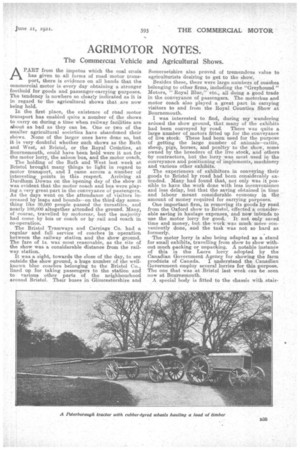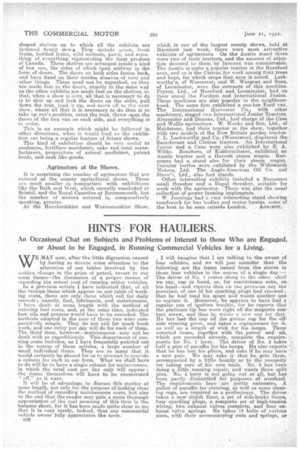AGRIMOTOR NOTES.
Page 33

Page 34

If you've noticed an error in this article please click here to report it so we can fix it.
The Commerciat Vehicle and Agricultural Shows.
APART from the impetus which the coal crisis has given to all forms of road motor transport, there is evidence on all hands that the commercial motor is every day obtaining a stronger foothold for goods and passenger-carrying purposes. The tendency is nowhere so clearly indicated as it is in regard to the agricultural shows that are now being held.
In the first place, the existence of road motor transport has enabled quite a number of the shows to carry on during a time when railway facilities are ahout as bad as they can be. One or two of the smaller agricultural societies have abandoned their shows. None of the larger ones have done so, but it is very doubtful whether such shows as the Bath and West, at Bristol, or the Royal Counties, at Bournemouth, could have been held were it not for the motor lorry, the saloon bus, and the motor coach.
The holding of the Bath and West last week at Bristol brought many things to light in regard to motor transport, and I came across a number of interesting points in this respect. Arriving at
• Durclham Downs on the Opening day of the show it was evident that the motor coach and bus were playing a very great part in the conveyance of passengers. As the days went on the attendance of visitors increased by leaps and bounds—on the third day something like 30,000 people passed the turnstiles, and nearly 100,000 altogether attended the ground. Many, of course, travelled by motorcar, but the majority had come by bus or coach or by rail and coach in
co-operation. _ The Bristol Tramways and Carriage Co. had a regular and full service of coaches in operation between the railway station and the show ground. The fare of is. was most reasonable, as the site of the show was a considerable distance from the railway station.
It was a sight, towards the close of the day, to see outside the show ground, a huge number of the wellknown blue coaches belonging to the Bristol Co., lined up for taking passengers to the station and to various other parts of the neighbourhood around Bristol. Their buses in Gloucestershire and Sonaersetshire also proved of tremendous value to agriculturists desiring to get to the show.
Besides these, there were large numbers of coaches belonging to other firms, including the "Greyhound" Motors, ‘.' Royal Mile," etc., all doing a good trade in the conveyance of passengers. The motorbus and motor coach also played a great Part in carrying visitors to and from the Royal Counties Show at Bournemouth.
I was interested to find, during ray wandering areamd the show ground, that many of the exhibits
had been conveyed by road. There was quite a large number of motors fitted up for the conveyance of live stock. These had been, used for the purpose of getting the large number of animals—cattle, sheep, pigs, horses, and poultry to the show, some owned by the breeders of the live stock, and others by contractors, but the lorry -was most used in the conveyance and positioning of implements, machinery and various other exhibits.
The experiences of exhibitors. in conveying their goads to Bristol by road had been considerably ex
tended. Many had found that, not only was it possible to have the work done with less inconvenience and less delay, but that the saving obtained in time and labour meant considerable economy in tic amount of money required for carrying purposes.
One important firm, in removing its goods by road from the Oxford show to Bristol, effected a consider
able saving in haulage expenses, and now intends to use the motor lorry for good. It not only saved time and Money, but the work was much more conveniently done, and the task was not so hard as formerly._
The motor lorry is also being adapted as a stand for small exhibits, travelling from Show to show with
out much packing or unpacking. A notable instance of this is the Laere lorry adopted by the Canadian Government Agency for showing the farm products of Canada. I understand the Canadian Government employ several lorries for this purp-ose. The one that was at Bristol last week ean he seen now at Bournemouth.
A special body is fitted to the chassis with stair
shaped shelves On. to which all the exhibits are fastened firmly clowei, They include grain, fresh fruits, bottled fruits, wild animals, game, and something of everything represeeting the farm produce
• of Canada. These shelves are arranged inside a kind of box van, the sides of which open midway in the form of doors. The doors on both sides fasten back, and have fixed on their insides sheaves of corn and • other things. These need not be unpacked, as they are made fast to the doors, exactly in the same way as the other exhibits are made fast on the shelves, so that, when a show is over, all that is necessary to do is to shut up and lock the doors on the sides, pull down the tent, load it up, and move elf to the next show, where all that it. is necessary to do then is to take up one's position, erect the tent, throw ripen the doors of the box van on each side, and everything is in order.
This is an example which might he followed in. other directions, when it would lead to the exhibition car tieing a regular feature of future shows.
This kind of exhibition should be very useful to seedsmen, fertilizer merchants, cake and meal manufacturers, proprietors of animal medicines, patent foods, and such like-goods.
Agrimotors at the Shows.
It is surprising tha number of agrimotors that are entered at the county agricultural shows. These are much smaller in comparison with exhibitions like the Bath and West, which recently concluded at Bristol, and the Royal Counties at I3ournemouth, but the number of motors entered is, comparatively speaking, geeater.
At the Herefordshire and Worcestershire Show, which is one of the largest county shows, held at Hereford last week, there were. most attractive exhibits of agrimotors. On the Austin stand there were two of their tractors, and the amount of attention devoted to them by farmers was considerable. The Austin is quite a popular tractor in the Hereford area, and so is the Cletrac, for work among fruit trees and hops, for which crops that area is noted. Larkworthy's, of Worcester, and W. Wargent and Sons, of Leominster, were the entrants of this machine: Fryers, Ltd., of Hereford and Leominster, had on their stand the Fordson and International Junior. These machines are also popular in the neighbourhood. The same firm exhibited 'a one-ton Ford van. The International Harvester Co.,ith other machinery, staged two International junior Tractors. Alexander and Duncan, Ltd. had charge of the Case
and Wallis agrimotors. W. Ltd., and Son, Ltd.„ of Maidstone, had their tractor at the show, together with two models of the New Britain garden tractor. J. L. Larkworthy and Co. (Worcester), displayed the Seunderson and Cletrac tractors. An International Junior and a Case were also exhibited by E. A. Bouchers, of Kidderminster, exhibited an Austin tractor and a Garrett .steam wagon. Ransomes had a stand also for their steam wagon. Daimler lorries were exhibited by the Widemarsh Motors, Ltd. The Anglo-American Oil Co. and Stern's. Ltd., also had stands.
Other interesting exhibits ineluded a Ransornes small thresher and a Depol thresher, suitable for work with the agrimoter. There was also the usual collection of power fanning implements. W. Jennings had a very interesting steed showing coachwork for bus bodies and motor lorries, some of
the best to be seen outside London. AGRI MOT.






































